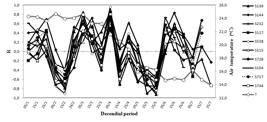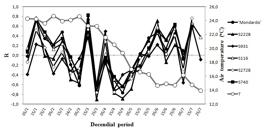ABSTRACT
The dormancy dynamics of temperate fruit tree species is complex and highly variable according to genotype and environment. Due to this variability, many phenological models of cold units have not been suitable for subtropical climatic conditions in southern Brazil. The aim of this study was to evaluate the influence of air temperature on the peach dormancy in Urussanga-SC. For this purpose, the correlations between the date of full bloom of sixteen peach varieties and the total hours in which the temperatures remain in certain thermal levels were evaluated. Two groups of varieties with highly differentiated responses to temperature in various times were identified. In the first group, consisting of ten varieties, the beginning of significant influence (p<0.05) of temperatures on the date of full bloom occurred as earlier, in February. In this group, temperatures between 16 and 22 °C accumulated from March to June were those that most contributed to the flowering advance. In the second group, the beginning of the significant influence of temperatures occurred later in April. In this group, the accumulated high temperatures from early April to late May anticipated the full bloom, but from May 25, temperatures below 10 °C were responsible for this advance. This behavior differs from traditional phenological models that consider a sequential cold and heat requirement in the resting phase. The results obtained indicate the possibility of an alternating or parallel influence of different temperature levels on dormancy.
Index terms
Prunus persica; dormancy; temperature; statistical method

 Thumbnail
Thumbnail
 Thumbnail
Thumbnail
 Thumbnail
Thumbnail
 Thumbnail
Thumbnail



